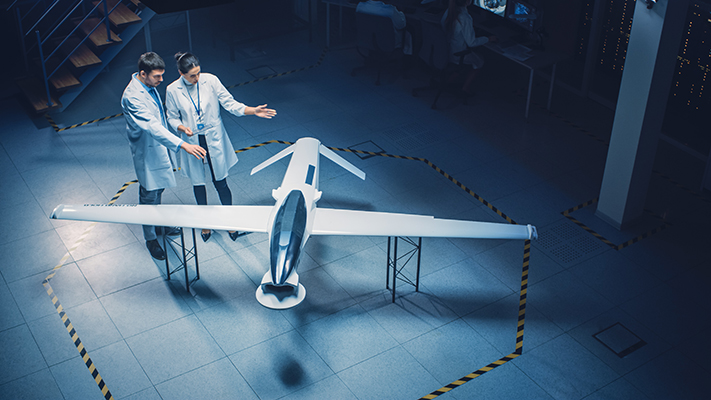More news
- Focus on the global coatings market: Global coatings market outlook
- View from the UK: Navigating chemical policy and sustainability
- Focus on adhesives: Unveiling unbreakable bonds – Testing redefines physical strengt...
- Focus on adhesives: Henkel and Covestro collaborate for sustainability of engineered wood ...
- Advances in construction chemical technology: What’s new in 2024?

Nikhil Kaitwade, Future Market Insights, gives an overview of the aerospace coatings market, focusing on Asia
Engineers are trying to offer better aerospace services to enhance the experience of consumers, improving aerospace coatings’ performance and durability with cutting-edge technologies.
Specialised coatings are helpful in that they offer protection against hazardous environments, including corrosion, UV radiation and moisture. Due to these coatings, aircraft become more durable, with increased performance. Manufacturers work closely with the aerospace sector by developing high-quality airplane paints. Here, we are talking about the advancements, types, and opportunities related aerospace coatings.
Typical aerospace coatings
Primer coatings: Primer is the first coating layer applied on the aerospace substrate. It enhances adhesion between subsequent and substrate layers of paint to improve performance.
Corrosion-resistance coatings: Corrosion-resistance coatings help to protect from moisture, corrosion, salt and other harmful factors. These coatings reach the underlying metal to prevent corrosive agents.
Antifouling coatings: Antifouling coatings are used to prevent buildup of marine organisms, including barnacles, algae and others on aircraft.
Heat-resistance coatings: Aircraft and aerospace vehicles and machines experience high temperatures during operation. Applying heat-resistance coatings to protect these vehicles from damage, including engine components, is essential.
Thermal barrier coatings: Another coating widely used for high-temperature areas to lower heat transfer and improve and protect the structure.
Abrasion-resistance coatings: Abrasion-resistance coatings are used on the aerospace surface to counter friction. These coatings extend the lifespan and enhance the protection of aerospace components.
Radome coatings: Radome coatings usually protect communication and radar systems in aerospace. These coatings are designed to protect from harmful environmental factors and transparent radio waves.
Low observable coatings: These coatings minimise electromagnetic wave reflection and radar cross-section, making aircraft less detectable to radar systems.
Topcoat coatings: These coatings are the final layer of coating that provides a variety of colours and aesthetic looks to aircraft and protects underlying layers.
These coatings are beneficial for aerospace advancements to improve performance and durability.
Opportunities in the Asian aerospace coatings market
The Asian aerospace industry is experiencing significant opportunities. Some of these potential opportunities are as follows:
Rapidly expanding aerospace market: The Asian market for aerospace coatings is rapidly growing due to increasing demand for aircraft, space and defence systems.
Rising air travel: The rising number of middle-class travellers, increased urbanisation and tourists are increasing the market size. The rising number of passengers increases the demand for aircraft and aerospace, directly increasing the demand for aerospace coatings for vehicle safety and maintenance.
Emerging low-cost carriers: Several Asian countries are increasing low-cost carriers due to the demand for durable, cost-effective and affordable air travel. Aerospace coatings helps to reduce maintenance costs.
Military modernisation programmes: Asian countries are heavily investing in military aviation and the defence sector, which will increase the opportunities in aerospace coatings. Manufacturers are adopting specialised coatings for drones, machines and vehicle equipment.
Space exploration and satellite industry: Private companies, space organisations and agencies focused on satellite developments are increasingly adopting specialised coatings. These coatings increase the opportunities to protect satellite components and withstand harsh environmental conditions.
Sustainability and environmental regulations: Rising environmental concerns are increasing the aerospace sector to increase the adoption of sustainability.
Advanced technology and innovation: Key companies are investing in research and development activities to create cutting-edge aerospace coatings. These companies are developing advanced coatings functionalities, including improved thermal management, self-healing properties and durability.
Expanding MRO (maintenance, repair and overhaul) market: The rapidly growing number of aircraft in Asian countries is increasing the adoption of MRO services. These aerospace coatings facilities enhance the market opportunities in the Asia region to support operations.
Development of huge aerospace infrastructure: Growing numbers of airports, maintenance services, manufacturing plants and construction of new airports increases the market opportunities in Asia. The rising demand for aerospace coatings increases longevity in these infrastructure activities.
Top three Asian countries expanding the aerospace coatings industry
The Asian market is vast and diverse in the aerospace coating sector. The increasing consumer preferences, changing lifestyles, increasing manufacturing activities and rising disposable incomes all fuel the aerospace coatings sector. The top three Asian countries that are fuelling the market are:
China: China is one of the leading countries in the region and has been rapidly growing over the last decade. China is heavily invested in research and development activities to enhance aerospace capabilities. With the increasing demand for aircraft services, the country is focusing on raising the production of aerospace coatings to drive the aerospace industry.
India: India is also witnessing significant growth by investing in defense and commercial aviation. The growing need for aerospace coatings is widely used to maintain, repair and protect aircraft. Indian key companies are significantly increasing the production of aerospace coatings to cater to domestic and international markets.
South Korea: South Korea increased the demand for aerospace coatings for aircraft components with advanced technology to fuel the country’s substantial growth. The country produces aerospace coatings to expand the aerospace market and meet end users’ demands.
Promoting sustainable practices
Manufacturers are looking towards sustainable practices to reduce environmental impacts in the aerospace sector. Some of the sustainable practices in aerospace coatings are as follows:
- Low volatile organic compounds formulations
- Water-based coatings
- Eco-friendly raw materials
- Recycling processes
- Educating and training
Through these aspects, manufacturers expect to advance the aerospace coatings industry.
Conclusions
In conclusion, the surging demand for sustainable and eco-friendly aerospace coatings is attracting end users’ demand as these coatings minimise environmental impacts. Compared to traditional coatings, these coatings reduce the chances of hazardous chemicals in the air. Therefore, aviation, aircraft and manufacturing plants adopt these specialised coatings to increase market revenue and maintain a clean environment.
The regulatory authorities are in charge of developing policies to reduce carbon emissions and enhance the quality of life. Key companies are also trying to maintain these regulations by developing cutting-edge technology. Day by day, the aerospace industry is growing larger with these new and innovative technologies.







